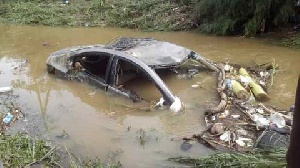 Lives are lost every year through floods
Lives are lost every year through floods
While growing up in the Volta Region, the rainy season was a period we impatiently anticipated.
This was because of the cold atmosphere it brought and also gave us a justifiable reason not to go to school on some days.
However, for the few years I have stayed in Accra, the situation has been entirely different. The rainy season has become more of a curse for residents in some communities in the capital city.
Any time it rains, the newspapers are replete with headlines such as “Floods in Accra,” “Again!, Accra submerged in water,” while television stations show images of houses that are submerged in water, cars and other valuables that go afloat, and reports of lives that are lost.
When victims of the flood are interviewed, they usually attribute it to structures built on watercourses. They’d conclude by asking the government to intervene.
Flashback
A classical example is the June 3, 2015 flood and fire disaster that claimed some 169 lives and destroyed properties running into thousands of Ghana cedis.
Social media was awash with dead bodies, vehicles in drains and the burnt filling station at the Kwame Nkrumah Circle. The rain, which was supposed to nourish crops and keep the atmosphere cool, ended up taking hundreds of innocent lives. Not even babies were spared.
This terrible flood was blamed on the indiscipline habit of Ghanaians littering the environment with plastic waste.
The central message on the lips of everyone was “Never Again!!.” Citizens were saying never again should people lose their lives during the rainy season.
The government at the time also promised never again should lives be lost. They promised to put in stringent measures to tackle the issue of littering and building on watercourses.
Nothing good
Three years down the line, our resolve of never again should people die during rainfall seem to be a mirage than a reality.
The latest to add to the casualties of flood victims in Accra is 32-year-old Dr Adjoa Aya Hayfron Oppong and six other people who lost their lives as a result of the torrential rains that hit some parts of Accra on Monday ( June 18, 2018).
Dr Hayfron Oppong is reported to have drowned when she attempted to drive through the flood near the Demo bridge at Teshie.
I was saddened by the plight of this mother of a 15-month-old child.
I asked myself “When would enough be enough?” When would the casualties of floods in Accra be enough for our politicians to wake up from their slumber of sloganeering and start implementing efficient long-term solutions to tackle the menace of floods in Accra?
Action
The last time I checked, there was no known prophecy claiming that the people of Accra were so filthy that God wanted to destroy them with floods like in the days of Noah.
Prayer, therefore, is out of the equation. This is a result of our own actions and inactions and it behoves us to solve it.
Tackling the menace of floods in Accra should be a concerted effort and not only government’s responsibility.
It is time we came together as a people and took an unbroken resolve to stop it.
An efficient waste management system should be established to tackle the uncontrollable waste generated in the capital city daily so that our gutters do not become the last resort for refuse.
In 2017, a research fellow, Urban Planning, United Nation’s Development Programme (UNDP), Ms Heather Troutman, revealed that Accra produces 300 tonnes of plastic waste in a day while less than two per cent of the wastes are recycled.
There is, therefore, the need to take bold steps to deploy an effective waste management regime if we want to make any headway in our quest to check the perennial flooding in Accra.
The Town and Country Planning Department should also be up and doing and stop allowing people to build on watercourses.
An Accra free of flood is possible. It’s time to get to work.